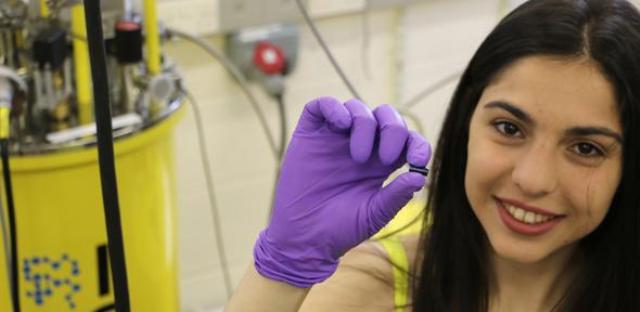Jul 6 2015
A research team led by the University of Cambridge has discovered that a single material could exhibit dual metal-insulator properties at the same time. This mysterious behaviour takes place at very low temperatures, and challenges the present understanding of the behaviour of metals, suggesting the existence of a new type of insulating state.
 PhD student Maria Kiourlappou holding a piece of SmB6. Credit: Suchitra Sebastian
PhD student Maria Kiourlappou holding a piece of SmB6. Credit: Suchitra Sebastian
This single material demonstrates the ability to behave as an insulator and as a conductor at the same time. Electrons flow freely in conductors, while they are mostly fixed in a single place in insulators.
Rubber, glass and other such materials are insulators that block or prevent electricity flow. On the other hand, metals and other such conductors have the ability to conduct electricity. The research team traced the path taken by the electrons as they flowed through a material. They observed that at the same instant, under very low temperature conditions, a single material had the ability to exhibit dual metal-insulator properties. The behavior of this material did not adhere to the rules of conventional metals. The team suspects that a potential third phase could be the reason for this behavior. In this phase, the material would be neither a conductor nor an insulator.
In this study, the team observed in samarium hexaboride (SmB6) that the bulk of the material simultaneously behaved as an insulator and as a conductor. SmB6 exhibited duelling metal-insulator properties throughout its interior. Recently other materials that behave as an insulator and as a conductor have been discovered. However, these materials had a sandwich-like structure that makes their surface and bulk to behave differently.
“The discovery of dual metal-insulator behaviour in a single material has the potential to overturn decades of conventional wisdom regarding the fundamental dichotomy between metals and insulators,” said Dr Suchitra Sebastian of the University’s Cavendish Laboratory, who led the research.
When the research team traced the electrons’ path through the material, the electrons’ orbit traced a geometrical surface, and this lead to a Fermi surface construction. A technique based on quantum oscillation measurements was used by the team to determine the Fermi surface. This technique helped to obtain the material’s accurate ‘fingerprint’ by measuring the material’s properties under high magnetic field conditions. The material should have purity to the highest possible extent in order to observe quantum oscillations. This would reduce defects to a minimum, ensuring that electrons don’t bump into these defects. The researchers conducted important experiments for this study at the National High Magnetic Field Laboratory in Tallahassee, Florida.
Kondo insulator materials demonstrate behavior that is close to the insulating-conducting border. SmB6 belongs to the Kondo insulator class of materials. Kondo insulators belong to the heavy fermion materials group, where complex physics exist. This is due to interplay between ‘d’ electrons and ‘f’ electrons. The ‘d’ electrons have larger orbits. The insulating behaviour in SmB6 arises due to correlations that take place between these electron types.
“It’s a dichotomy,” said Sebastian. “The high electrical resistance of SmB6 reveals its insulating behaviour, but the Fermi surface we observed was that of a good metal.”
The team encountered more mysteries. At temperatures near 0 K (-273°C), SmB6 had quantum oscillations that did not belong to conventional metals. For metals, when the temperature is lowered the amplitude of quantum oscillations grows before levelling off.
The team observed that even as the temperature was lowered, the amplitude of quantum oscillations continued to increase in SmB6.
Several reasons were considered to find an answer for this behaviour. In one, a novel phase that was neither a conductor nor an insulator was proposed. An alternative considered that because SmB6 possesses a very small ‘gap’ between its conducting and insulating behaviors, electrons could possibly be jumping that gap. Another possibility is that the material could be fluctuating between the conducting and insulating states.
“The crossover region between two different phases – magnetic and non-magnetic, for example – is where the really interesting physics happens,” said Sebastian. “Because this material is close to the crossover region between insulator and conductor, we found it displays some really strange properties – we’re exploring the possibility that it’s a new quantum phase.”
Tim Murphy, the head of the National High Magnetic Field Laboratory’s DC Field Facility, where most of the research was conducted, said: “This work on SmB6 provides a vivid and exciting illustration of emergent physics resulting from MagLab researchers refining the quality of the materials they study and pushing the sample environment to the extremes of high magnetic fields and low temperatures.”
The results of this study have been published in the journal Science.
The Royal Society, the European Research Council, the Winton Programme for the Physics of Sustainability, and the Engineering and Physical Sciences Research Council (UK) have provided funding for this study.